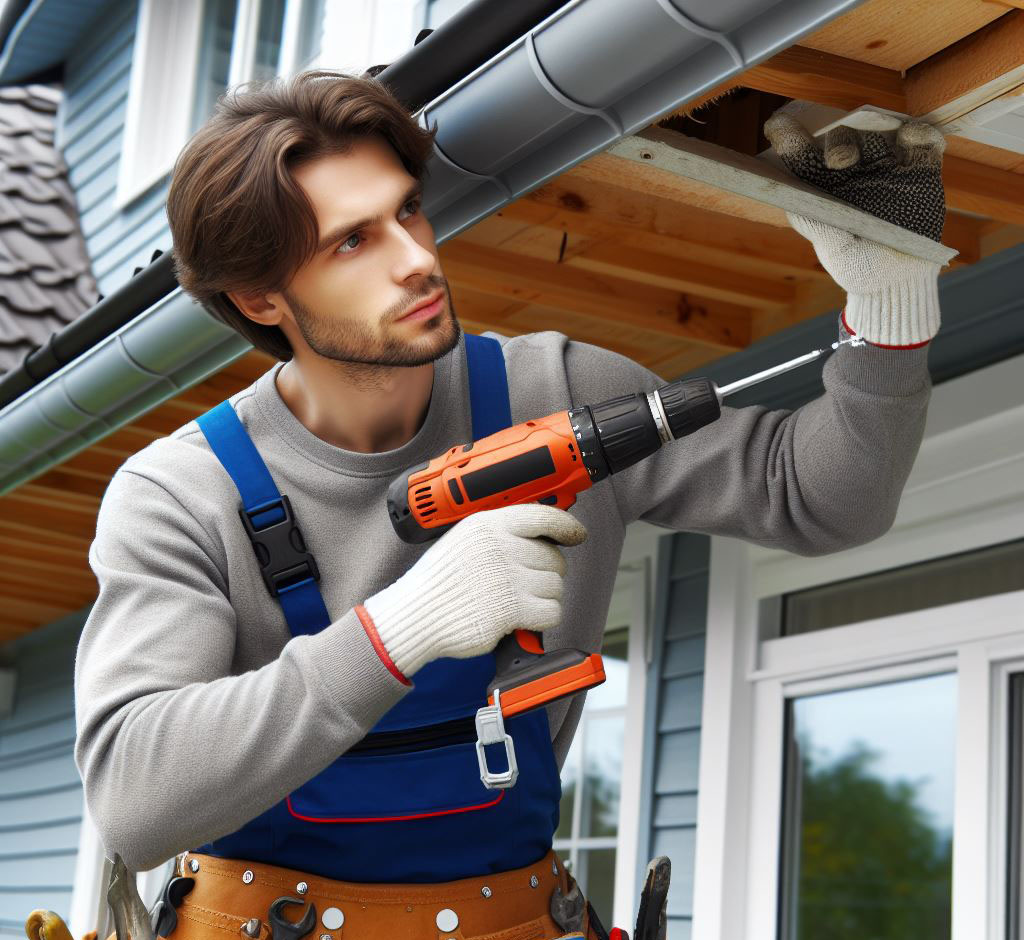In the grand scheme of home maintenance, soffit and fascia often fly under the radar, yet their role is anything but minor. These architectural elements not only enhance the visual appeal of your home but are also vital for protecting its structure and ensuring proper ventilation. The soffit, tucked away under the roof’s overhang, allows your attic to breathe, preventing the accumulation of moisture that can lead to decay. The fascia, running along the roof’s edge, is the mounting point for gutters and acts as a barrier against water intrusion. The longevity of your home hinges on the health of these components, making their upkeep paramount.

Understanding Soffit and Fascia
What They Are and Why They Matter
- Soffit serves as the lungs for your attic, facilitating the flow of air that helps regulate temperature and moisture levels, crucial for a healthy, mold-free home.
- Fascia provides the finishing touch to the edge of your roof, offering aesthetic appeal while protecting the roof and interior from water damage.
Choosing Your Materials: A Builder’s Guide
- Wood: Offers a timeless look but demands regular upkeep to ward off rot and insects.
- Vinyl: A favorite for its durability and minimal maintenance, resistant to rot and fading.
- Aluminum: Stands up well to the elements, easy to maintain, and can be painted to match your home’s exterior, though susceptible to dents.
- Composite: Mimics wood’s appearance without the maintenance hassles, albeit at a higher initial cost.

Signs of Damage and When to Repair
Reading the Signs: A Builder’s Checklist
- Peeling Paint: More than an aesthetic issue, this signals potential moisture problems.
- Rot and Mold: Indicators of excessive moisture and poor ventilation, necessitating immediate action.
- Pest Damage: Open or damaged areas invite pests. Prompt repairs are crucial to prevent infestation.
- Weather Damage: Weather extremes can exacerbate minor issues, leading to significant damage. Look for signs of wear after severe weather events.
Why Regular Inspections Are Non-Negotiable
Routine checks of your home’s exterior are akin to preventative medicine, catching potential issues before they escalate into major repairs. A biannual inspection, in spring and autumn, can save you from unexpected expenses and headaches. If heights are not your comfort zone, or if you’re unsure of what to look for, consider enlisting a professional. This proactive approach is key to maintaining not only the aesthetic appeal of your home but its structural integrity as well.

Preparation for Soffit and Fascia Repair
Before embarking on any soffit and fascia repair project, it’s imperative to approach the task with meticulous preparation and a keen eye for safety. In the realm of home repair, thoroughness in both planning and execution is paramount. This guide draws on years of hands-on experience in the field, aiming to equip you with the knowledge and techniques to tackle soffit and fascia repairs with confidence and efficiency.
Safety First, Always
Embarking on repairs requires more than just a can-do attitude, it necessitates a rigorous commitment to safety. Equip yourself with protective eyewear, durable gloves, and a hard hat to shield against unforeseen accidents. A robust ladder, correctly positioned, forms the foundation of your work setup, ensuring stability as you navigate the heights of your project. For extensive repairs, consider the added security and accessibility of scaffolding, transforming a precarious balancing act into a stable platform for precision work.
Tools and Materials Checklist
- Arm yourself with the basics: a reliable hammer, a versatile set of screwdrivers, and a circular or handsaw for precise material cuts.
- A tape measure is indispensable, ensuring accuracy in every measurement and cut.
- Stock up on replacement materials that match the existing soffit and fascia, preserving the aesthetic continuity of your home.
- Caulk and a caulking gun are essential for sealing edges and gaps, ensuring a watertight finish.
- Lastly, quality paint and brushes will restore the fresh, like-new appearance of your repairs.
Setting Up the Work Area
Creating a safe and efficient work environment is crucial. Begin by clearing the ground area to eliminate potential hazards that could impede your movement or cause accidents. Employ ladder stabilizers to ensure your ladder remains firmly in place, safeguarding against slips or shifts. Secure any dangling wires or cables, removing electrical hazards from your workspace.

DIY Soffit and Fascia Repair Techniques
Fixing the Soffit Like a Pro
- Remove Damaged Sections: Approach this step with the precision of a surgeon, carefully extracting the compromised soffit to avoid damaging the intact sections.
- Cut New Soffit Pieces: Adhering to the adage of “measure twice, cut once,” prepare your replacement pieces, ensuring they fit seamlessly into the designated space.
- Secure in Place: Fasten the new soffit gently, avoiding excessive force that could compromise the integrity of the material.
Fascia Repair 101
- Remove Damaged Fascia: This may require a bit more force. Employ a crowbar with care, prying away the old fascia without disturbing the underlying roof structure.
- Prep the New Fascia: Measure and cut your new fascia with precision. Painting prior to installation is advisable, facilitating a cleaner, more efficient application.
- Install the New Fascia: Attach the new fascia securely, ensuring it aligns perfectly with the roofline and presents a neat, polished appearance.
Ensuring Proper Ventilation
When replacing soffit panels, opt for vented options if applicable, to maintain adequate attic ventilation. Be mindful not to obstruct existing ventilation spaces when sealing gaps, balancing moisture protection with the need for air circulation.

Soffit and Fascia Replacement
In the vast and nuanced world of home renovation, the decision to repair or replace soffit and fascia is not one to be taken lightly. These critical components not only define the aesthetic appeal of your home but also protect it from the elements. With years of experience under my belt, I’ve come to appreciate the fine balance between preservation and renewal in maintaining a home’s integrity. Let’s delve into the practicalities of when replacement trumps repair, the process of rejuvenation, and the ongoing care that ensures longevity.
When to Replace Over Repair
- Consider the Long-Term: When the soffit and fascia are extensively damaged or have reached the end of their serviceable life, replacement is often more cost-effective than ongoing repairs.
- Upgrading for Home Efficiency: New materials can offer improved durability, better ventilation, and enhanced energy efficiency, contributing to a healthier home environment and potential savings on energy bills.
A Step-by-Step Guide to Replacement
- The Removal Process: Begin by carefully dismantling the existing soffit and fascia, taking care not to damage the roof or the house’s siding. This task requires patience and precision.
- Material Selection: Choose materials that align with your home’s architectural style and your climate’s demands. Whether you opt for the low-maintenance appeal of vinyl and aluminum or the natural beauty of wood, each choice comes with its maintenance profile and lifespan.
- Installation Insights: Install the soffit first, ensuring it’s correctly ventilated to allow your attic to breathe. Follow up with the fascia, securing it firmly in place. Proper installation is critical to prevent future issues such as warping or water ingress.

Finishing Touches and Maintenance
Protective Measures
Apply a high-quality sealant and paint to shield your soffit and fascia from weathering. This not only prolongs their life but also enhances your home’s curb appeal.
Routine Care
Regularly clear your gutters and check the ventilation of your soffit to prevent moisture buildup. An inspection in the spring and fall can help identify and rectify potential issues before they escalate.
FAQ Section
The durability of soffit and fascia materials varies. Vinyl and aluminum are celebrated for their longevity and minimal upkeep. Wood, while requiring more maintenance, offers unmatched aesthetic versatility.
This depends on the extent of the damage and your comfort level with home improvement projects. Minor repairs may be within the realm of a skilled DIYer, whereas significant damage might necessitate the expertise of a professional.
A biannual inspection is recommended to identify any signs of wear or damage early. This proactive approach can mitigate the need for more extensive, costly repairs down the line.
Costs can vary widely based on the extent of the damage, the materials chosen, and whether you opt for DIY or professional repair. Setting aside a budget for maintenance can help manage these expenses.
Preventative maintenance is key. Ensure that gutters are clear, soffit vents are unobstructed, and any signs of damage or wear are addressed promptly to maintain the structural integrity and appearance of your home.
